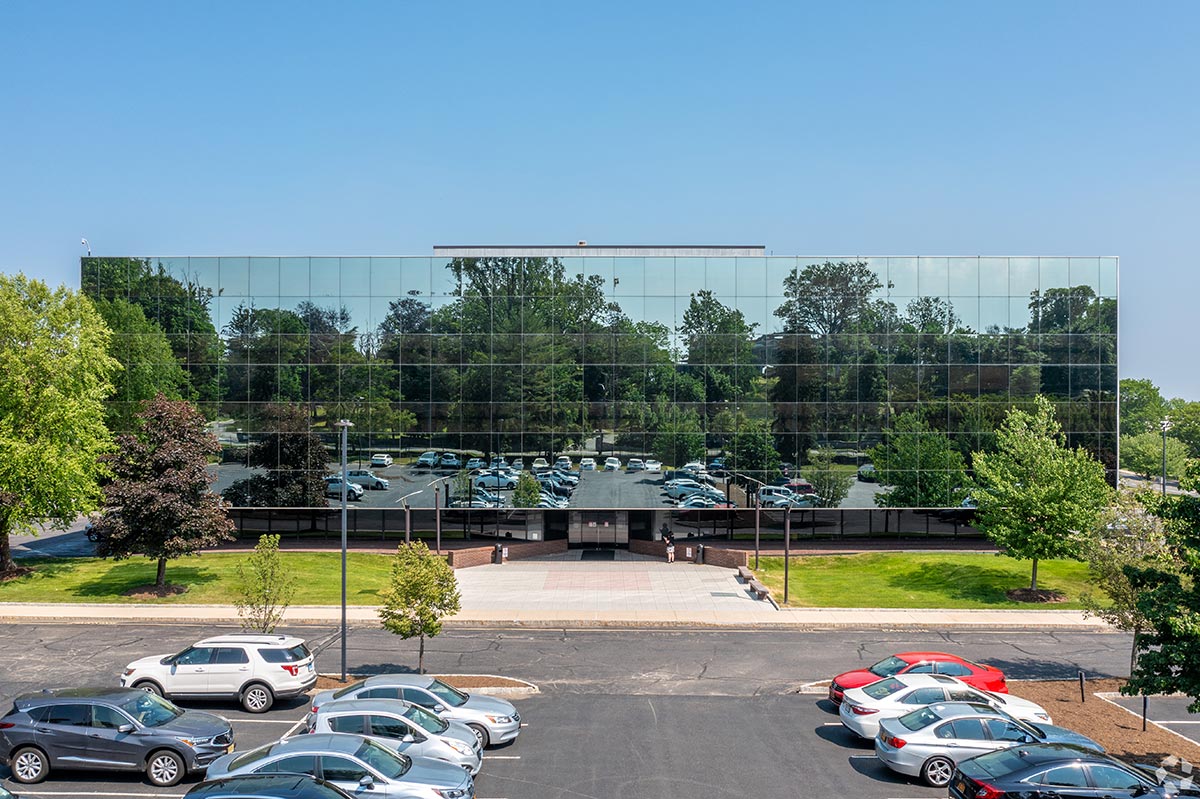Simone Development Announces Acquisition of One Executive Boulevard Office Building in the Heart of the North Yonkers Medical Mile

133,768-Square-Foot, 4-Story Property to be Repurposed Into State-of-the-Art Medical Space
Building Strategically Located Within 1/4 Mile of 879,426 Square Feet of Existing Medical Space
YONKERS, NY (October 4, 2023) — In a major medical redevelopment that will enhance the “Medical Mile” in North Yonkers, Simone Development Companies has acquired One Executive Boulevard, a 133,768-square-foot, 4-story office building located within 1/4 mile of 879,426 square feet of existing medical office space.
Simone Development, a leader in the development of modern medical office space, has begun interior and exterior renovations to repurpose the property into a state-of-the-art medical building. Located on 6.7 acres at the intersection of Executive Boulevard and North Broadway, One Executive Boulevard offers excellent visibility and accessibility to major highways and mass transit with abundant parking. The seller was an affiliate of Robert Martin Company.
One Executive Boulevard complements the North Yonkers Medical Mile that includes Simone’s highly successful Boyce Thompson Center. The 85,000-square-foot mixed-use center features physician’s offices of St. John’s Riverside Hospital, Westmed/Summit Health, ENT & Allergy Associates, Columbia Doctors and other medical practices along with retail shops and restaurants.
One Executive Boulevard also neighbors Simone Development’s 1034 North Broadway, a 25,000-square-foot, recently renovated multi-tenant medical building that includes Northwell Health as well as Trust Specialty Pharmacy, the first pharmacy and drug compounding retail location in Yonkers.
Other well-known healthcare providers within the North Yonkers Medical Mile include St. John’s Family Medical Practice, Elizabeth Seton Children’s Center, Riverhill Radiation Oncology, and Northway Medical Center.
One Executive Boulevard is conveniently located near three major hotels: Courtyard by Marriott, Residence Inn by Marriott and Hampton Inns & Suites with a total of 337 rooms.
“Our acquisition of this important property located in the heart of what we see as the North Yonkers Medical Mile fits perfectly with our vision for this vibrant and growing healthcare community. Our investment in the Medical Mile began with our redevelopment of the Boyce Thompson Center, which has successfully attracted top-level medical tenants. Moving forward, we foresee continued strength in the healthcare sector here with its easy access to Southern and Central Westchester, Riverdale and the North Bronx,” said Joe Simone, President of Simone Development Companies.
“This sale reflects Westchester’s evolving commercial real estate market,” stated Robert Martin Company CEO Tim Jones. “1 Executive Boulevard is well-positioned for medical redevelopment, and we are excited to see Simone Development expand its footprint in the local healthcare marketplace.”
“Simone Development’s vision for Yonkers continues to elevate our economy,” said Yonkers Mayor Mike Spano. “Investing in Yonkers’ growing healthcare industry is smart and brings more jobs and momentum to the city. I look forward to seeing the expansion of Yonkers’ Medical Mile.”
One Executive Boulevard currently has roughly 50,000 square feet of medical space available for lease. For more information, please contact Josh Gopan, Vice President of Leasing at Simone Development, or Jeremy Schwartz, Director of Leasing at Simone Development, at 718-215-3000.
Real Estate visionary to lead NYC effort to build culture of health for all – Joe Simone named Centennial Chair of the 2024 Heart of New York City campaign

New York, NY, September 20, 2023 —Joe Simone, President of Simone Development Companies, has been named Centennial Chair of the American Heart Association’s Heart of New York City, a year-round effort aimed at investing in and saving and improving lives in the five boroughs. The Heart of New York City culminates with the Heart of New York City Gala in June, an event that celebrates progress made through the dedication and passion of all who support this community-wide campaign.
“The American Heart Association is dedicated to the extension of life through a commitment to science, education, improving medical care and leading with prevention. This is why I am honored to serve as Chair of the 2024 Heart of New York City campaign and look forward to celebrating the impact we will make,” said Joe Simone, President of Simone Development Companies, and member of the American Heart Association New York City Board of Directors. “I am eager to work with our outstanding team of volunteer leaders and the American Heart Association as we all advocate to make a difference in the well-being of everyone in this community. Together we must continue to strive to do everything we can to make a lasting, positive impact on the health of all New Yorkers.”
In 2024 the American Heart Association will celebrate its centennial year, meaning that Mr. Simone will have the special distinction of serving as the Heart of New York City campaign’s Centennial Chair. Mr. Simone will also serve on the prestigious American Heart Association New York City Board of Directors from July 2023 through June 2025.
“The American Heart Association has worked to save and improve lives since 1924—and it’s just getting started,” Simone said. “I invite all New Yorkers to join us in celebrating the American Heart Association’s transformative impact over the past century and building a second century of equitable health for all.”
The American Heart Association’s centennial is a celebration of the lifesaving achievements and shared vision for a bold second century that will exponentially advance heart and brain health. The Association will continue to lead breakthroughs in science and technology, improve healthcare and advocate for federal, state and local policies that drive healthier lifestyles.
“Joe understands the impact the mission and work of the American Heart Association can have on every person who lives in this area. We welcome him to the Heart of New York City, an initiative that centers around better health for every individual by focusing on critical issues and work to equitably improve and save lives,” says Meg Gilmartin, Executive Director and Senior Vice President, American Heart Association, New York City.
The 2024 Heart of New York City Gala is sponsored by Simone Development Companies, and Compass One Healthcare. It is slated for June 2024 at venue TBD. The annual celebratory event is a night to honor survivors, patrons and volunteers of the American Heart Association, the world’s leading nonprofit organization focused on heart and brain health. The evening will feature stories from survivors, as well as dinner, dancing and an exciting auction. For more information on how to support or attend the Heart of New York City Gala, visit the campaign website or contact sydney.hoffman@heart.org.
About the American Heart Association
The American Heart Association is a relentless force for a world of longer, healthier lives. We are dedicated to ensuring equitable health in all communities. Through collaboration with numerous organizations, and powered by millions of volunteers, we fund innovative research, advocate for the public’s health and share lifesaving resources. The Dallas-based organization has been a leading source of health information for nearly a century. Connect with us on heart.org, Facebook, Twitter or by calling 1-800-AHA-USA1.
About Simone Development Companies
Simone Development Companies is a full-service real estate investment company specializing in the acquisition and development of healthcare, mixed-use, office, industrial, retail and residential properties. Headquartered at the Hutchinson Metro Center, it boasts a portfolio of over 7 million square feet throughout the Bronx, Manhattan, Queens, Long Island, Westchester County, Orange and Fairfield Counties and New Jersey. With expertise spanning acquisition, development, construction, finance, asset management, accounting, leasing and property management, Simone Development Companies is set apart by its vertically integrated management team, long-term asset ownership and its pursuit of visionary development.
Simone Healthcare Development and Catholic Health Celebrate the Opening of New $47 Million Ambulatory & Urgent Care Center in Centereach, Long Island
Simone Transformed a Former Retail Building Into
a 63,000 SF State-of-the-Art, Multispecialty Care Center
CENTEREACH, NY (August 2, 2023) – Simone Healthcare Development and Catholic Health today joined with officials from the Town of Brookhaven to celebrate the opening of Catholic Health Ambulatory & Urgent Care at Centereach, a new multispecialty care center featuring primary care and specialty services as well as walk-in urgent care.
The new state-of-the-art center is part of Catholic Health’s growing network of multispecialty care centers, complete with diagnostic imaging, an on-site pharmacy, and a dedicated suite where Catholic Health’s gastroenterologists can perform endoscopy procedures in a safe, comfortable and convenient environment outside the hospital setting.
Simone Healthcare Development, a division of Simone Development Companies and a leader in medical office and ambulatory care facility development, acquired the 63,000 square foot facility located at 2112 Middle Country Road from Ocean State Job Lot, the largest closeout retailer in the Northeast, in 2022. Simone Healthcare Development has invested $30 million into the redevelopment of the property and is leasing the new healthcare facility to Catholic Health. Ocean State Job Lot continues to own and operate a 36,000 square foot store adjacent to Catholic Health.
This multi-faceted project was a collaborative partnership between the Simone Healthcare Development team and Catholic Health. Simone’s development team was responsible for site selection, securing land use approvals and managing the design and construction of the façade, site and core, while Simone’s property management team will manage the 10-acre site. The development required approvals from the Town of Brookhaven Planning Board and Building Department and the Suffolk County Department of Health.
Newman Design, as architect for Simone, designed a new exterior that is architecturally distinct from the adjacent retail use. It features a glass and limestone façade, a second entrance for urgent care, and a new glass canopy to provide a covered drop-off for patients. In addition to Simone’s investment, the new facility is part of Catholic Health’s $17 million project that further strengthens Catholic Health’s goal of making quality healthcare more convenient for Long Islanders and to support many of the unmet healthcare needs of the community. Primary and specialty care services will be offered in 43,000 square-feet of space immediately with an additional 20,000 square-feet available for future healthcare services.
“We are delighted to celebrate this incredible transformation of a former retail site into a state-of-the-art multispecialty ambulatory and urgent care center for Catholic Health,” said Joseph Simone, President of Simone Development Companies. “It was a true collaboration between our teams to be able to deliver this first-rate facility in just one year. This remarkable facility is an example of a major trend in healthcare real estate where under-utilized retail spaces are being converted into new urgent care, ambulatory centers and doctors’ offices as expanding health networks such as Catholic Health seek locations that are attractive to and convenient for their patients.”
“Today marks an important day not only for Catholic Health but also for the residents in and near Centereach, who now have access to exceptional primary care, urgent care, and specialized care across a wide variety of medical specialties,” said Catholic Health President & CEO Patrick O’Shaughnessy, DO, MBA. “We’ve recently launched a number of Ambulatory Care sites across Long Island, however, today we open our largest and most expansive. This is truly a milestone, both for Catholic Health and for Suffolk County.”
About Simone Development Companies
Simone Development Companies is a full-service real estate investment company specializing in the acquisition and development of healthcare, mixed-use, office, industrial, retail and residential properties. Headquartered at the Hutchinson Metro Center, it boasts a portfolio of over 7 million square feet throughout the Bronx, Manhattan, Queens, Long Island, Westchester County, Orange and Fairfield Counties and New Jersey. With expertise spanning acquisition, development, construction, finance, asset management, accounting, leasing and property management, Simone Development Companies is set apart by its vertically integrated management team, long-term asset ownership and its pursuit of visionary development.
About Catholic Health
Catholic Health is an integrated system encompassing some of the region’s finest health and human services agencies. The health system has nearly 16,000 employees, six acute care hospitals, three nursing homes, a home health service, hospice and a network of physician practices. Under the sponsorship of the Diocese of Rockville Centre, Catholic Health serves hundreds of thousands of Long Islanders each year, providing care that extends from the beginning of life to helping people live their final years in comfort, grace and dignity.


